Modeling of Organic Fouling in an Ultrafiltration Cell Using Different Three-Dimensional Printed Turbulence Promoters
Abstract
:1. Introduction
2. Materials and Methods
2.1. Model Dairy Wastewater
2.2. Laboratory Dead-End Ultrafiltration Cell
2.3. Design of 3DP PLA Promoters
2.4. Mathematical Models Used for Modeling
2.5. Organic Rejection Calculations and COD Measurements
2.6. Reynolds Number Calculation
2.7. Computational Fluid Dynamics (CFD) in Autodesk
3. Results and Discussion
3.1. Permeate Flux Results
3.2. Ultrafiltration Membrane Rejections
3.3. Resistance Results
3.4. Hermia Model Results
3.5. Reynolds Number Results
3.6. CFD of Ultrafiltration Cell
4. Conclusions
Author Contributions
Funding
Institutional Review Board Statement
Data Availability Statement
Conflicts of Interest
Abbreviations
| RT | total resistance (m−1) |
| RM | membrane resistance (m−1) |
| RIRR | irreversible resistance (m−1) |
| RREV | reversible resistance (m−1) |
| Jv | water flux on the clean membrane (m s−1) |
| ηv | water viscosity (Pa s) |
| Δp | transmembrane pressure (Pa) |
| Jv1 | water flux after filtration (m s−1) |
| Jss | steady-state flux (m s−1) |
| ηp | permeate viscosity (Pa s) |
| t | filtration time (s) |
| V | permeate volume (m3) |
| K and n | Hermia fouling models parameters |
| J | the flux (L m−2 h−1) |
| J0 | the flux at time t = 0 (L m−2 h−1) |
| kc, ks, ki, kg | Hermia constants |
| R | rejection (%) |
| cP | concentration of the permeate (mg L−1) |
| cF | concentration of the feed (the dairy wastewater) (mg L−1) |
| Re | Reynolds number |
| ρ | density of the water (kg m−3) |
| u | dynamic viscosity of water (Pa s) |
| D | diameter of the magnetic stirrer (m) |
| ω | stirrer speed (s−1) |
| TMP | transmembrane pressure (Pa) |
References
- Luo, J.; Cao, W.; Ding, L.; Zhu, Z.; Wan, Y.; Jaffrin, M.Y. Treatment of Dairy Effluent by Shear-Enhanced Membrane Filtration: The Role of Foulants. Sep. Purif. Technol. 2012, 96, 194–203. [Google Scholar] [CrossRef]
- Szabo-Corbacho, M.A.; Pacheco-Ruiz, S.; Míguez, D.; Hooijmans, C.M.; Brdjanovic, D.; García, H.A.; van Lier, J.B. Influence of the Sludge Retention Time on Membrane Fouling in an Anaerobic Membrane Bioreactor (AnMBR) Treating Lipid-Rich Dairy Wastewater. Membranes 2022, 12, 262. [Google Scholar] [CrossRef]
- Lakra, R.; Choudhury, S.; Basu, S. Recovery of Protein and Carbohydrate from Dairy Wastewater Using Ultrafiltration and Forward Osmosis Processes. Mater. Today Proc. 2021, 47, 1400–1403. [Google Scholar] [CrossRef]
- Hube, S.; Eskafi, M.; Hrafnkelsdóttir, K.F.; Bjarnadóttir, B.; Bjarnadóttir, M.Á.; Axelsdóttir, S.; Wu, B. Direct Membrane Filtration for Wastewater Treatment and Resource Recovery: A Review. Sci. Total Environ. 2020, 710, 136375. [Google Scholar] [CrossRef] [PubMed]
- Da Cunha, T.M.P.; Canella, M.H.M.; Haas, I.C.d.S.; Amboni, R.D.d.M.C.; Prudencio, E.S. A Theoretical Approach to Dairy Products from Membrane Processes. Food Sci. Technol. 2022, 42, 1–9. [Google Scholar] [CrossRef]
- Teodoro, J.A.; Arend, G.D.; Proner, M.C.; Verruck, S.; Rezzadori, K. A Review on Membrane Separation Processes Focusing on Food Industry Environment-Friendly Processes. Crit. Rev. Food Sci. Nutr. 2022, 1–15. [Google Scholar] [CrossRef]
- Akter, M.; Park, J.-S. Fouling and Mitigation Behavior of Foulants on Ion Exchange Membranes with Surface Property in Reverse Electrodialysis. Membranes 2023, 13, 106. [Google Scholar] [CrossRef]
- Zhao, F.; Han, X.; Shao, Z.; Li, Z.; Li, Z.; Chen, D. Effects of Different Pore Sizes on Membrane Fouling and Their Performance in Algae Harvesting. J. Memb. Sci. 2022, 641, 119916. [Google Scholar] [CrossRef]
- Guo, W.; Ngo, H.-H.; Li, J. A Mini-Review on Membrane Fouling. Bioresour. Technol. 2012, 122, 27–34. [Google Scholar] [CrossRef]
- Todisco, F.; Vergni, L.; Ceppitelli, R. Modelling the Dynamics of Seal Formation and Pore Clogging in the Soil and Its Effect on Infiltration Using Membrane Fouling Models. J. Hydrol. 2023, 618, 129208. [Google Scholar] [CrossRef]
- Obotey Ezugbe, E.; Rathilal, S. Membrane Technologies in Wastewater Treatment: A Review. Membranes 2020, 10, 89. [Google Scholar] [CrossRef] [PubMed]
- Niu, C.; Li, X.; Dai, R.; Wang, Z. Artificial Intelligence-Incorporated Membrane Fouling Prediction for Membrane-Based Processes in the Past 20 Years: A Critical Review. Water Res. 2022, 216, 118299. [Google Scholar] [CrossRef] [PubMed]
- Sutrisna, P.D.; Kurnia, K.A.; Siagian, U.W.R.; Ismadji, S.; Wenten, I.G. Membrane Fouling and Fouling Mitigation in Oil–Water Separation: A Review. J. Environ. Chem. Eng. 2022, 10, 107532. [Google Scholar] [CrossRef]
- Dagar, S.; Singh, S.K.; Gupta, M.K. Integration of Pre-Treatment with UF/RO Membrane Process for Waste Water Recovery and Reuse in Agro-Based Pulp and Paper Industry. Membranes 2023, 13, 199. [Google Scholar] [CrossRef]
- Kotsanopoulos, K.V.; Arvanitoyannis, I.S. Membrane Processing Technology in the Food Industry: Food Processing, Wastewater Treatment, and Effects on Physical, Microbiological, Organoleptic, and Nutritional Properties of Foods. Crit. Rev. Food Sci. Nutr. 2015, 55, 1147–1175. [Google Scholar] [CrossRef] [PubMed]
- Al-Shimmery, A.; Mazinani, S.; Ji, J.; Chew, Y.M.J.; Mattia, D. 3D Printed Composite Membranes with Enhanced Anti-Fouling Behaviour. J. Memb. Sci. 2019, 574, 76–85. [Google Scholar] [CrossRef]
- Padaki, M.; Murali, R.S.; Abdullah, M.S.; Misdan, N.; Moslehyani, A.; Kassim, M.A.; Hilal, N.; Ismail, A.F. Membrane Technology Enhancement in Oil–Water Separation. A Review. Desalination 2015, 357, 197–207. [Google Scholar] [CrossRef]
- Maruf, S.H.; Wang, L.; Greenberg, A.R.; Pellegrino, J.; Ding, Y. Use of Nanoimprinted Surface Patterns to Mitigate Colloidal Deposition on Ultrafiltration Membranes. J. Memb. Sci. 2013, 428, 598–607. [Google Scholar] [CrossRef]
- Choi, W.; Chan, E.P.; Park, J.-H.; Ahn, W.-G.; Jung, H.W.; Hong, S.; Lee, J.S.; Han, J.-Y.; Park, S.; Ko, D.-H. Nanoscale Pillar-Enhanced Tribological Surfaces as Antifouling Membranes. ACS Appl. Mater. Interfaces 2016, 8, 31433–31441. [Google Scholar] [CrossRef]
- Khalil, A.; Ahmed, F.E.; Hilal, N. The Emerging Role of 3D Printing in Water Desalination. Sci. Total Environ. 2021, 790, 148238. [Google Scholar] [CrossRef]
- Navarro, A.B.; Nogalska, A.; Garcia-Valls, R. A 3D Printed Membrane Reactor System for Electrochemical CO2 Conversion. Membranes 2023, 13, 90. [Google Scholar] [CrossRef] [PubMed]
- Wiese, M.; Nir, O.; Wypysek, D.; Pokern, L.; Wessling, M. Fouling Minimization at Membranes Having a 3D Surface Topology with Microgels as Soft Model Colloids. J. Memb. Sci. 2019, 569, 7–16. [Google Scholar] [CrossRef]
- Cheng, M.; Xie, X.; Schmitz, P.; Fillaudeau, L. Extensive Review about Industrial and Laboratory Dynamic Filtration Modules: Scientific Production, Configurations and Performances. Sep. Purif. Technol. 2021, 265, 118293. [Google Scholar] [CrossRef]
- Beuscher, U.; Kappert, E.J.; Wijmans, J.G. Membrane Research beyond Materials Science. J. Memb. Sci. 2022, 643, 119902. [Google Scholar] [CrossRef]
- Tsai, H.-Y.; Huang, A.; Luo, Y.-L.; Hsu, T.-Y.; Chen, C.-H.; Hwang, K.-J.; Ho, C.-D.; Tung, K.-L. 3D Printing Design of Turbulence Promoters in a Cross-Flow Microfiltration System for Fine Particles Removal. J. Memb. Sci. 2019, 573, 647–656. [Google Scholar] [CrossRef]
- Ng, V.H.; Koo, C.H.; Chong, W.C.; Tey, J.Y. Progress of 3D Printed Feed Spacers for Membrane Filtration. Mater. Today Proc. 2021, 46, 2070–2077. [Google Scholar] [CrossRef]
- Koo, J.W.; Ho, J.S.; An, J.; Zhang, Y.; Chua, C.K.; Chong, T.H. A Review on Spacers and Membranes: Conventional or Hybrid Additive Manufacturing? Water Res. 2021, 188, 116497. [Google Scholar] [CrossRef]
- Qian, X.; Ostwal, M.; Asatekin, A.; Geise, G.M.; Smith, Z.P.; Phillip, W.A.; Lively, R.P.; McCutcheon, J.R. A Critical Review and Commentary on Recent Progress of Additive Manufacturing and Its Impact on Membrane Technology. J. Memb. Sci. 2021, 645, 120041. [Google Scholar] [CrossRef]
- Khan, S.B.; Irfan, S.; Lam, S.S.; Sun, X.; Chen, S. 3D Printed Nanofiltration Membrane Technology for Waste Water Distillation. J. Water Process. Eng. 2022, 49, 102958. [Google Scholar] [CrossRef]
- Ibrahim, Y.; Hilal, N. The Potentials of 3D-Printed Feed Spacers in Reducing the Environmental Footprint of Membrane Separation Processes. J. Environ. Chem. Eng. 2022, 11, 109249. [Google Scholar] [CrossRef]
- Hodúr, C.; Szpisják-Gulyás, N.; Lemmer, B.; Jákói, Z.; Kertész, S.; László, Z.; Veréb, G.; Beszédes, S. Comparison of Filtering Models for Milk Substitutes. J. Food Sci. Technol. 2021, 58, 4429–4436. [Google Scholar] [CrossRef] [PubMed]
- Nourbakhsh, H.; Emam-Djomeh, Z.; Mirsaeedghazi, H.; Omid, M.; Moieni, S. Study of Different Fouling Mechanisms during Membrane Clarification of Red Plum Juice. Int. J. Food Sci. Technol. 2014, 49, 58–64. [Google Scholar] [CrossRef]
- Salahi, A.; Abbasi, M.; Mohammadi, T. Permeate Flux Decline during UF of Oily Wastewater: Experimental and Modeling. Desalination 2010, 251, 153–160. [Google Scholar] [CrossRef]
- Vela, M.C.V.; Blanco, S.Á.; García, J.L.; Rodríguez, E.B. Analysis of Membrane Pore Blocking Models Applied to the Ultrafiltration of PEG. Sep. Purif. Technol. 2008, 62, 489–498. [Google Scholar] [CrossRef]
- Mohammadi, T.; Kazemimoghadam, M.; Saadabadi, M. Modeling of Membrane Fouling and Flux Decline in Reverse Osmosis during Separation of Oil in Water Emulsions. Desalination 2003, 157, 369–375. [Google Scholar] [CrossRef]
- Amin, I.N.H.M.; Mohammad, A.W.; Markom, M.; Peng, L.C.; Hilal, N. Analysis of Deposition Mechanism during Ultrafiltration of Glycerin-Rich Solutions. Desalination 2010, 261, 313–320. [Google Scholar] [CrossRef]
- Wang, Y.; Serventi, L. Sustainability of Dairy and Soy Processing: A Review on Wastewater Recycling. J. Clean. Prod. 2019, 237, 117821. [Google Scholar] [CrossRef]
- Wang, F.; Tarabara, V.V. Pore Blocking Mechanisms during Early Stages of Membrane Fouling by Colloids. J. Colloid Interface Sci 2008, 328, 464–469. [Google Scholar] [CrossRef]
- Sarkar, B. A Combined Complete Pore Blocking and Cake Filtration Model during Ultrafiltration of Polysaccharide in a Batch Cell. J. Food Eng. 2013, 116, 333–343. [Google Scholar] [CrossRef]
- Ng, C.Y.; Mohammad, A.W.; Ng, L.Y.; Jahim, J.M. Membrane Fouling Mechanisms during Ultrafiltration of Skimmed Coconut Milk. J. Food Eng. 2014, 142, 190–200. [Google Scholar] [CrossRef]
- Kerdi, S.; Qamar, A.; Vrouwenvelder, J.S.; Ghaffour, N. Fouling Resilient Perforated Feed Spacers for Membrane Filtration. Water Res. 2018, 140, 211–219. [Google Scholar] [CrossRef] [PubMed]
- Sreedhar, N.; Thomas, N.; Al-Ketan, O.; Rowshan, R.; Hernandez, H.; Al-Rub, R.K.A.; Arafat, H.A. 3D Printed Feed Spacers Based on Triply Periodic Minimal Surfaces for Flux Enhancement and Biofouling Mitigation in RO and UF. Desalination 2018, 425, 12–21. [Google Scholar] [CrossRef]
- Chang, H.; Ho, C.-D.; Chen, Y.-H.; Chen, L.; Hsu, T.-H.; Lim, J.-W.; Chiou, C.-P.; Lin, P.-H. Enhancing the Permeate Flux of Direct Contact Membrane Distillation Modules with Inserting 3D Printing Turbulence Promoters. Membranes 2021, 11, 266. [Google Scholar] [CrossRef] [PubMed]
- Sreedhar, N.; Kumar, M.; al Jitan, S.; Thomas, N.; Palmisano, G.; Arafat, H.A. 3D Printed Photocatalytic Feed Spacers Functionalized with β-FeOOH Nanorods Inducing Pollutant Degradation and Membrane Cleaning Capabilities in Water Treatment. Appl. Catal. B 2022, 300, 120318. [Google Scholar] [CrossRef]

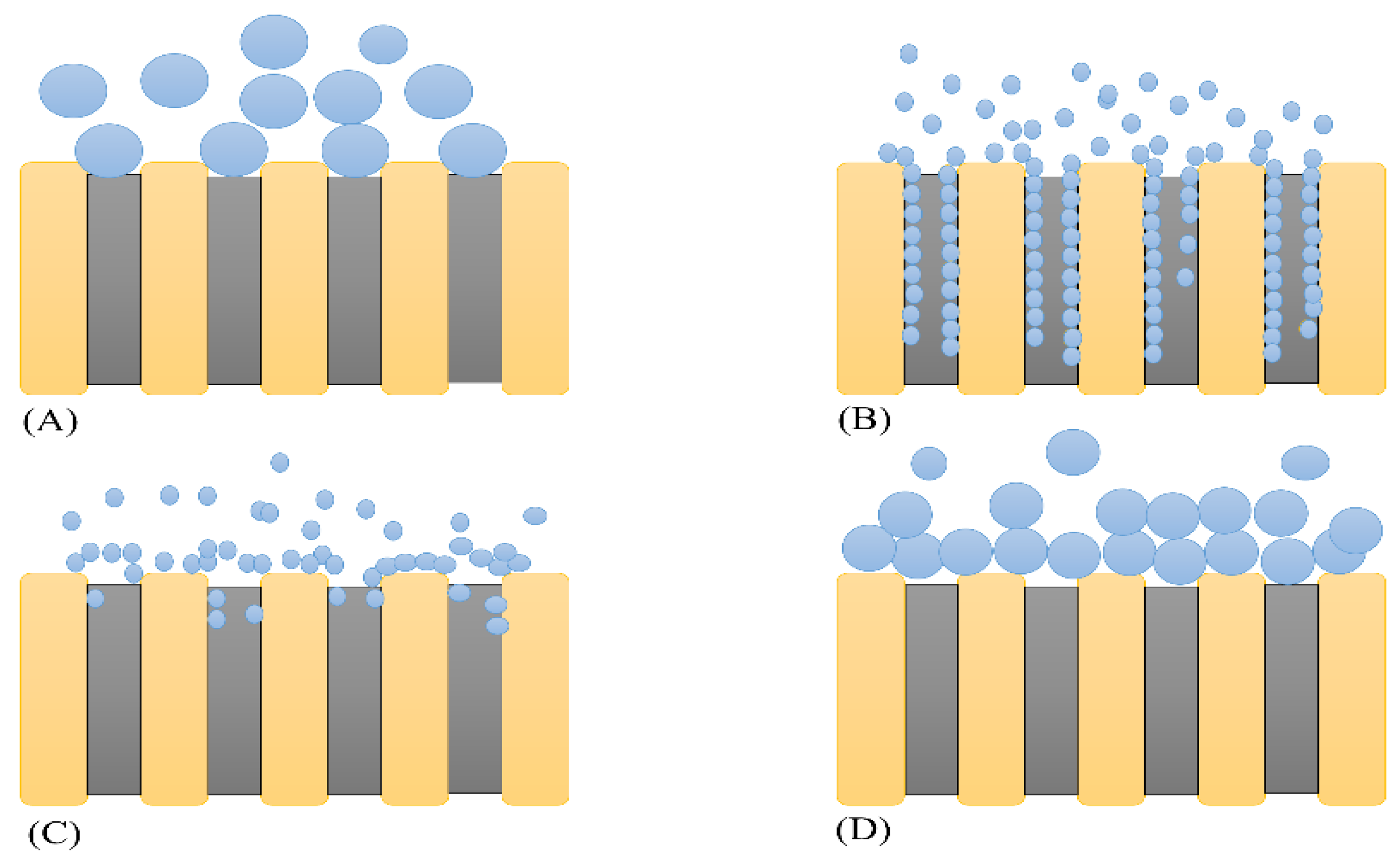

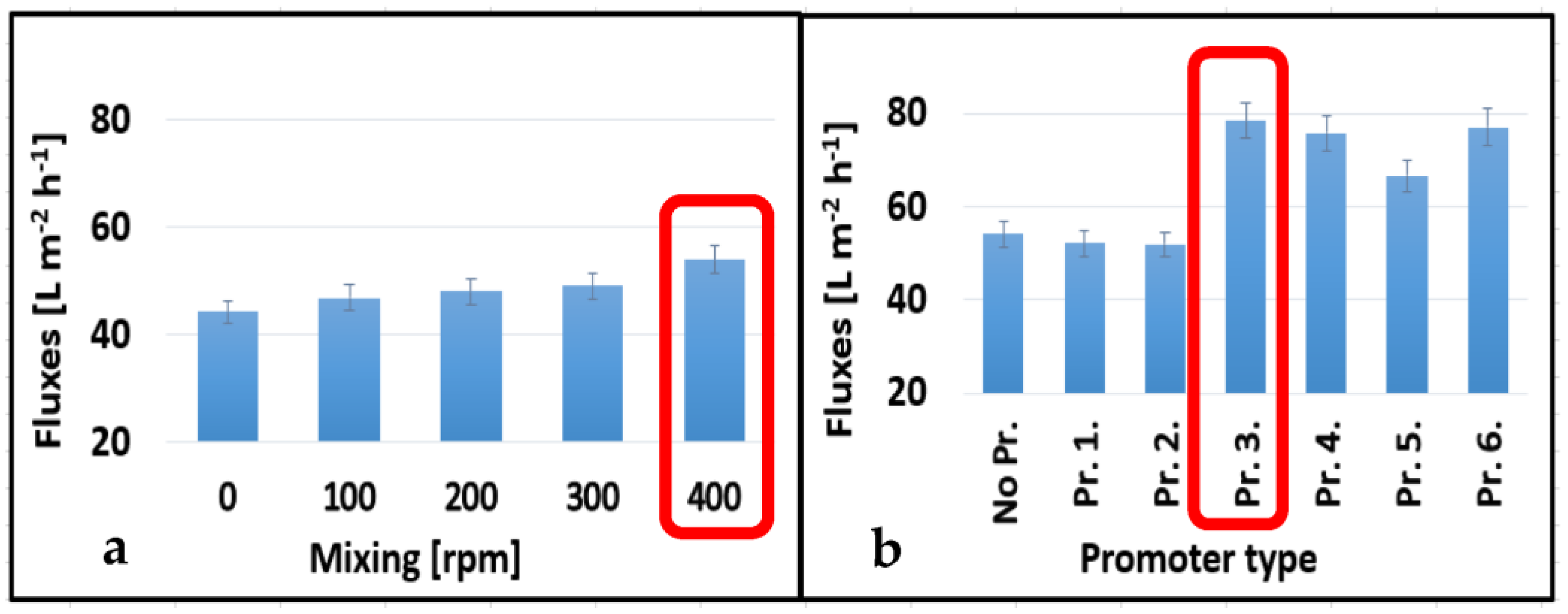
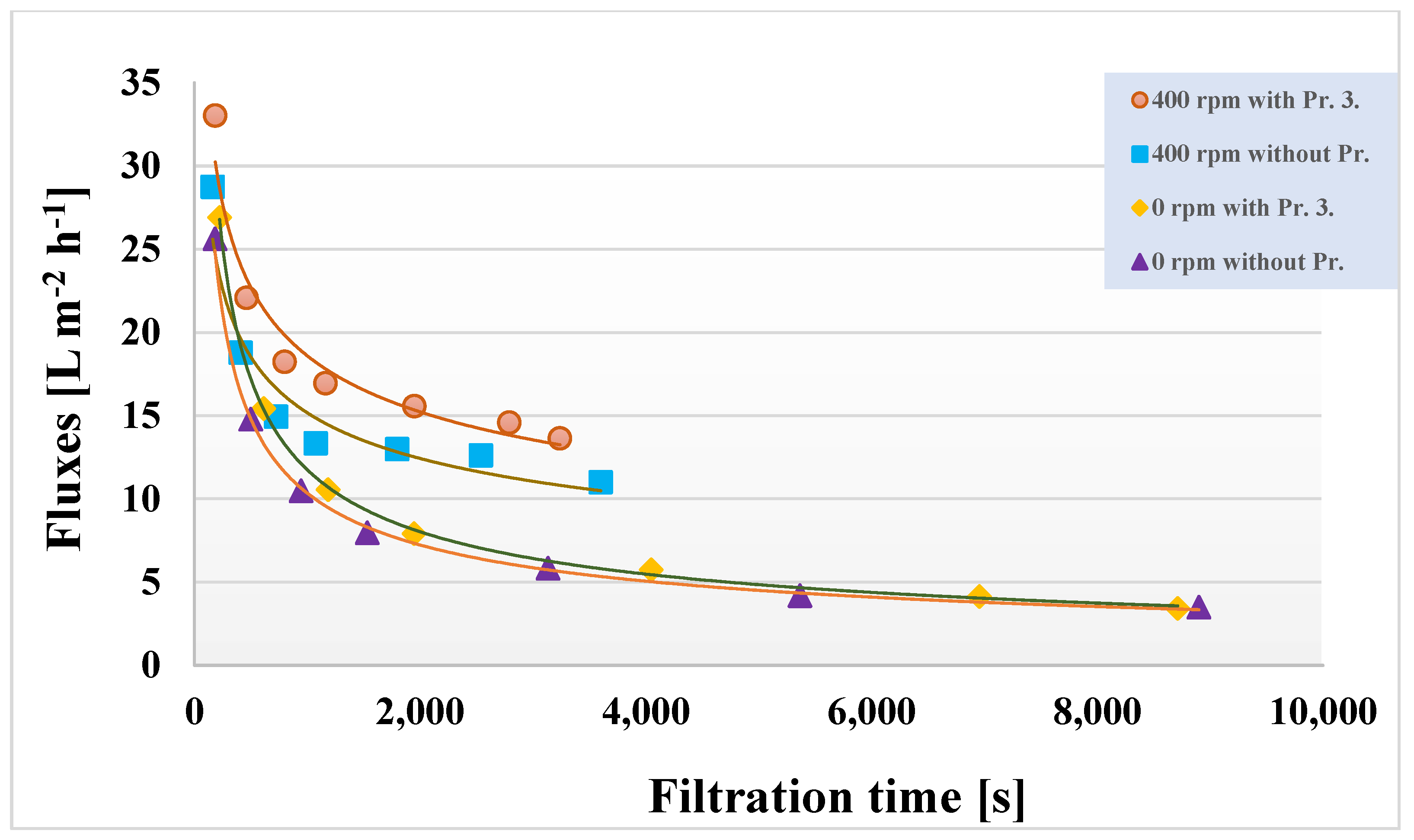

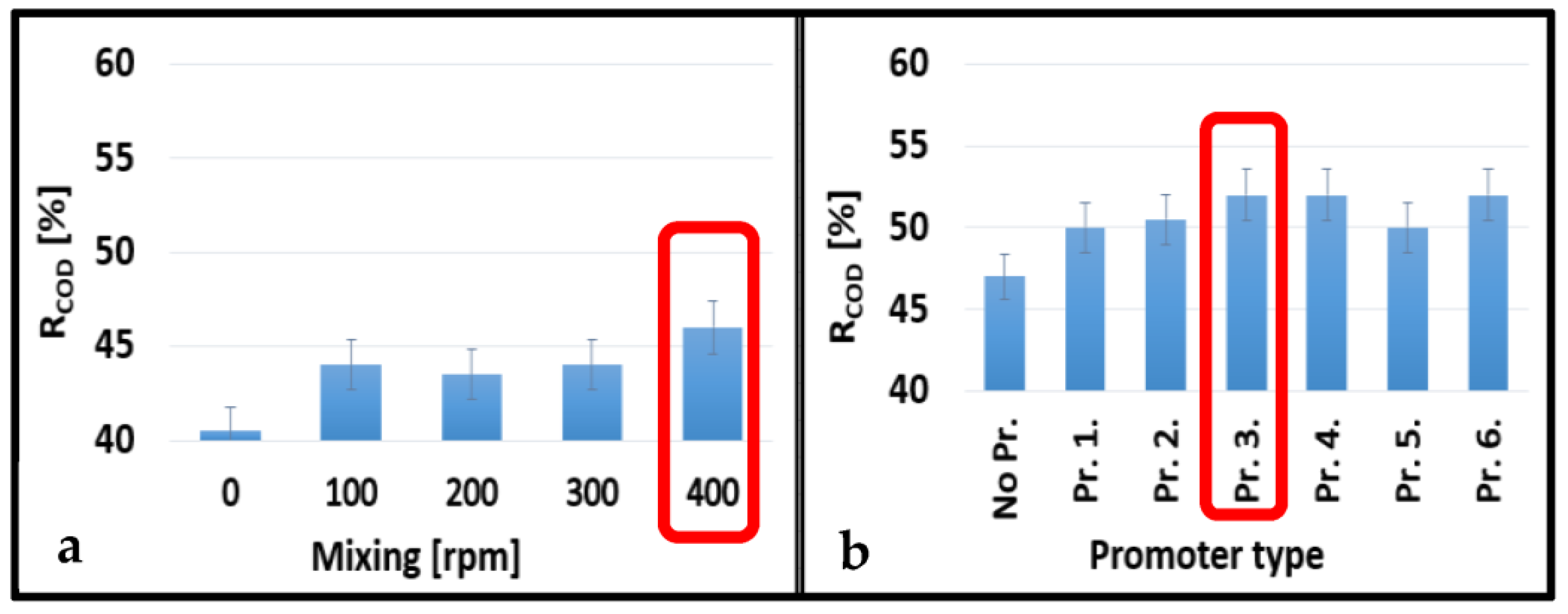

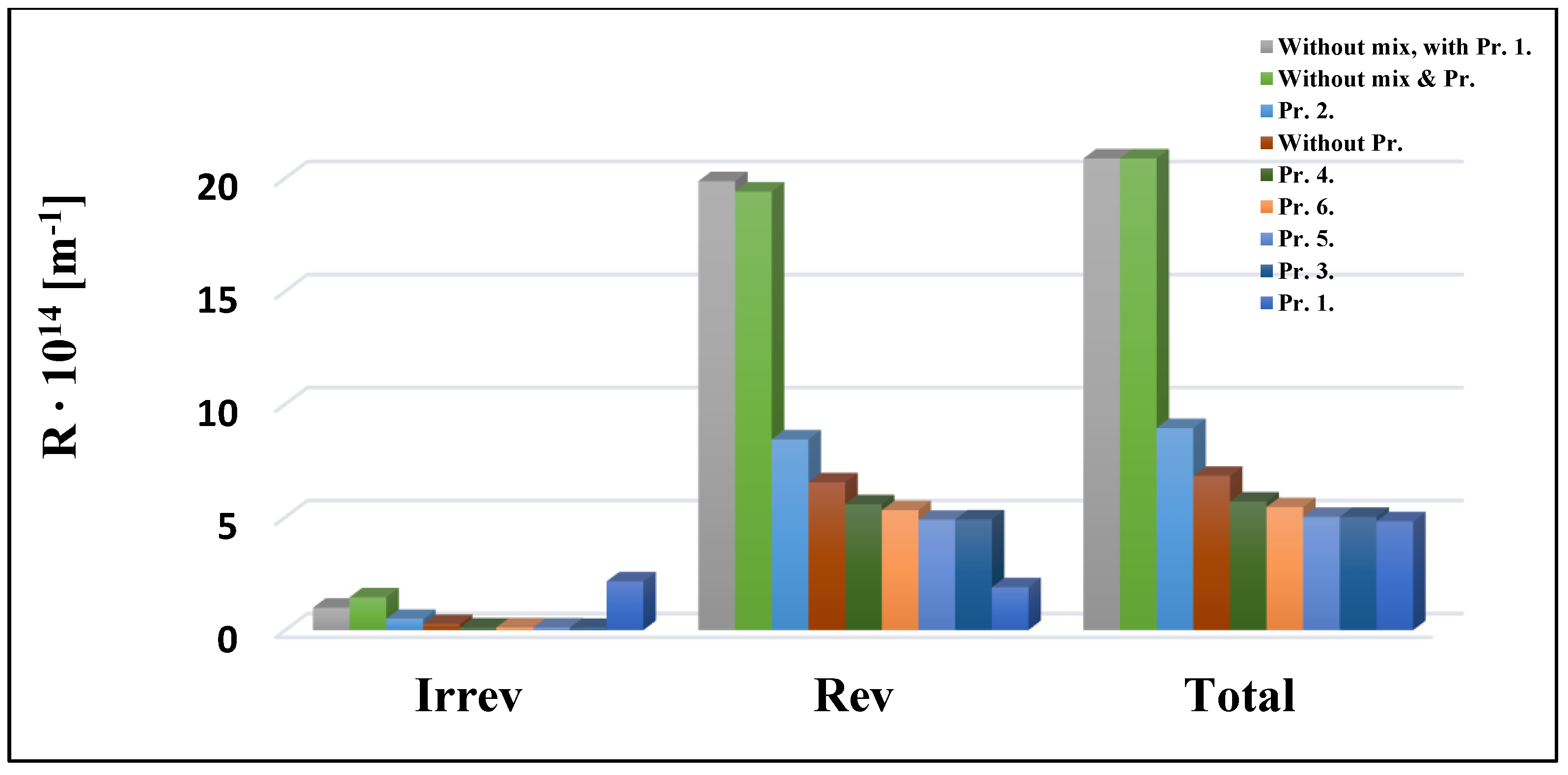
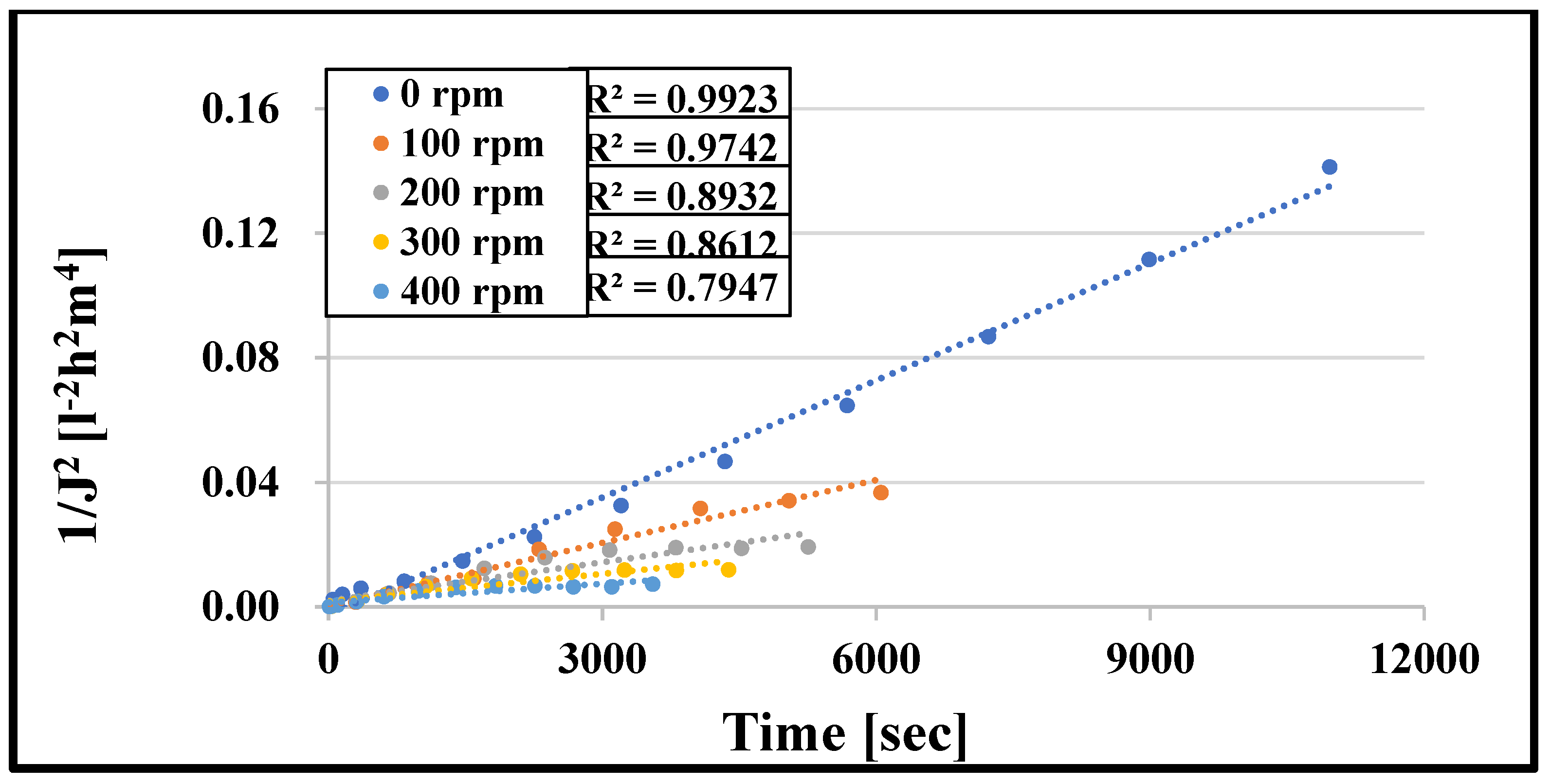

| Complete Blocking Model n = 2 | Standard Blocking Model n = 1.5 | Intermediate Blocking Model n = 1 | Cake Layer Formation Model n = 0 |
|---|---|---|---|
| (6) | (7) | (8) | (9) |
| Stirring Speed (rpm) | n = 2 | n = 1.5 | n = 1 | n = 0 | Rrev |
|---|---|---|---|---|---|
| 0 rpm | 0.8618 | 0.9389 | 0.9842 | 0.9923 | 11.06 |
| 100 rpm | 0.6876 | 0.8242 | 0.9117 | 0.9742 | 10.22 |
| 200 rpm | 0.6296 | 0.7353 | 0.8124 | 0.8932 | 8.15 |
| 300 rpm | 0.6201 | 0.708 | 0.7772 | 0.8612 | 6.08 |
| 400 rpm | 0.5859 | 0.6603 | 0.7193 | 0.7947 | 4.23 |
| Turbulence Promoter Type | n = 2 | n = 1.5 | n = 1 | n = 0 | Rrev |
|---|---|---|---|---|---|
| Pr. 1. | 0.8513 | 0.891 | 0.9253 | 0.9737 | 4.9 |
| Pr. 2. | 0.6206 | 0.7205 | 0.8056 | 0.9198 | 3.44 |
| Pr. 3. | 0.6509 | 0.7537 | 0.8396 | 0.9483 | 3.46 |
| Pr. 4. | 0.6367 | 0.7459 | 0.8379 | 0.9526 | 3.92 |
| Pr. 5. | 0.6337 | 0.7377 | 0.8235 | 0.9315 | 3.45 |
| Pr. 6. | 0.6395 | 0.7316 | 0.8093 | 0.9127 | 3.43 |
| Stirring Speed (rpm) | n = 2 | n = 1.5 | n = 1 | n = 0 | Rrev |
|---|---|---|---|---|---|
| 0 rpm | 0.664 | 0.8524 | 0.9601 | 0.9945 | 14.19 |
| 100 rpm | 0.5788 | 0.8014 | 0.9213 | 0.9893 | 13.52 |
| 200 rpm | 0.5646 | 0.7695 | 0.8867 | 0.9711 | 11.02 |
| 300 rpm | 0.5042 | 0.6637 | 0.7701 | 0.8791 | 7.49 |
| 400 rpm | 0.4846 | 0.6246 | 0.7201 | 0.8271 | 6.54 |
| Turbulence Promoter Type | n = 2 | n = 1.5 | n = 1 | n = 0 | Rrev |
|---|---|---|---|---|---|
| Pr. 1. | 0.546 | 0.727 | 0.8509 | 0.9584 | 6.72 |
| Pr. 2. | 0.5322 | 0.6987 | 0.8125 | 0.9312 | 4.12 |
| Pr. 3. | 0.5313 | 0.6963 | 0.813 | 0.9385 | 4.2 |
| Pr. 4. | 0.5548 | 0.7036 | 0.8153 | 0.9416 | 5.09 |
| Pr. 5. | 0.5823 | 0.7091 | 0.8099 | 0.9329 | 4.19 |
| Pr. 6. | 0.5842 | 0.7161 | 0.8184 | 0.9388 | 4.87 |
Disclaimer/Publisher’s Note: The statements, opinions and data contained in all publications are solely those of the individual author(s) and contributor(s) and not of MDPI and/or the editor(s). MDPI and/or the editor(s) disclaim responsibility for any injury to people or property resulting from any ideas, methods, instructions or products referred to in the content. |
© 2023 by the authors. Licensee MDPI, Basel, Switzerland. This article is an open access article distributed under the terms and conditions of the Creative Commons Attribution (CC BY) license (https://creativecommons.org/licenses/by/4.0/).
Share and Cite
Kertész, S.; Gulyás, N.S.; Al-Tayawi, A.N.; Huszár, G.; Lennert, J.R.; Csanádi, J.; Beszédes, S.; Hodúr, C.; Szabó, T.; László, Z. Modeling of Organic Fouling in an Ultrafiltration Cell Using Different Three-Dimensional Printed Turbulence Promoters. Membranes 2023, 13, 262. https://doi.org/10.3390/membranes13030262
Kertész S, Gulyás NS, Al-Tayawi AN, Huszár G, Lennert JR, Csanádi J, Beszédes S, Hodúr C, Szabó T, László Z. Modeling of Organic Fouling in an Ultrafiltration Cell Using Different Three-Dimensional Printed Turbulence Promoters. Membranes. 2023; 13(3):262. https://doi.org/10.3390/membranes13030262
Chicago/Turabian StyleKertész, Szabolcs, Nikolett Sz. Gulyás, Aws N. Al-Tayawi, Gabriella Huszár, József Richárd Lennert, József Csanádi, Sándor Beszédes, Cecilia Hodúr, Tamás Szabó, and Zsuzsanna László. 2023. "Modeling of Organic Fouling in an Ultrafiltration Cell Using Different Three-Dimensional Printed Turbulence Promoters" Membranes 13, no. 3: 262. https://doi.org/10.3390/membranes13030262
APA StyleKertész, S., Gulyás, N. S., Al-Tayawi, A. N., Huszár, G., Lennert, J. R., Csanádi, J., Beszédes, S., Hodúr, C., Szabó, T., & László, Z. (2023). Modeling of Organic Fouling in an Ultrafiltration Cell Using Different Three-Dimensional Printed Turbulence Promoters. Membranes, 13(3), 262. https://doi.org/10.3390/membranes13030262









